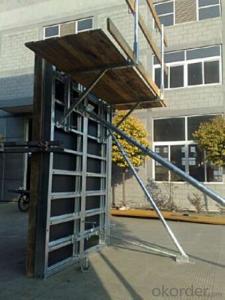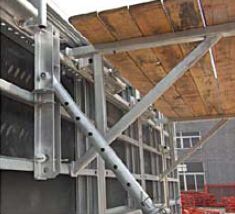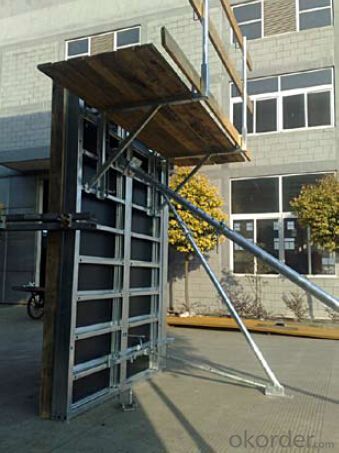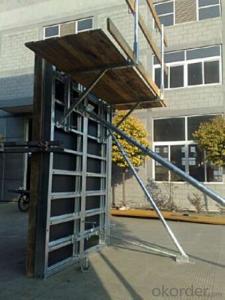Steel-Frame Formwork working platform
- Loading Port:
- China Main Port
- Payment Terms:
- TT OR LC
- Min Order Qty:
- -
- Supply Capability:
- -
OKorder Service Pledge
OKorder Financial Service
You Might Also Like
Steel-frame Formwork SF-140
Characteristics:
◆ Few parts for fast forming.
◆ Max. Concrete pressure: 80KN/m2.
◆ Hot-dip galvanized steel frame.
◆ The thickness of plywood is 18mm & the panel is 14cm.
◆ Compatibility with Hunnebeck Manto system due to similar edge profile.
System Details & Application:
◆ Neat joint and fast assembling with aligning panel clamp.
◆ Flexible panel arrangement and height extension.
◆ The selection of panels.
◆ Kinds of panel connectors.
◆ Corner clamp application.
◆ Length adjustment application.
◆ Height adjustment & aligning strut.
◆ Walkway bracket & platform.
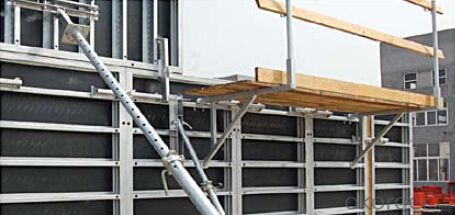
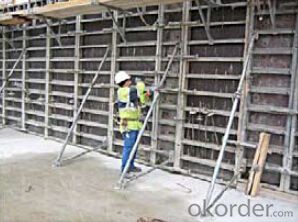
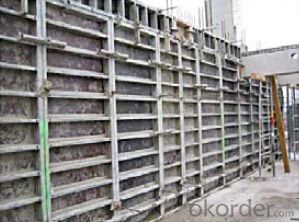
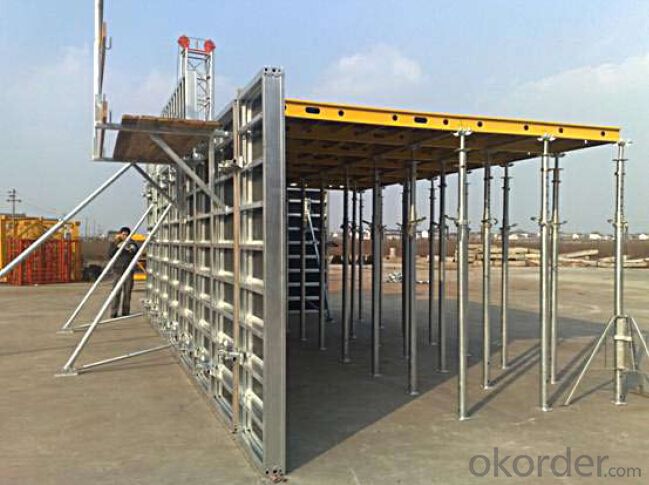
- Q: Can steel formwork be used in bridge construction projects?
- In bridge construction projects, steel formwork can be utilized. Steel formwork is a temporary structure employed to support and shape the concrete throughout the construction phase. It is extensively applied in diverse construction projects, including bridges. By employing steel formwork, several advantages are obtained in bridge construction, such as enhanced strength, durability, and resistance to deformation. The structure can withstand the weight of the concrete and other construction materials, thereby guaranteeing the stability and integrity of the bridge. Moreover, steel formwork offers flexibility in creating intricate bridge designs, enabling the construction of various bridge types, such as arch bridges, cable-stayed bridges, and suspension bridges. The integration of steel formwork in bridge construction projects aids in simplifying the construction process, enhancing efficiency, and ensuring the quality of the final bridge structure.
- Q: How does steel formwork contribute to the strength of the structure?
- There are several ways in which steel formwork enhances the strength of a structure. To begin with, steel is a durable and robust material, making it perfect for withstanding the pressures and loads that a structure may encounter. This strength enables the formwork to support the weight of the concrete during pouring and setting, ensuring that it remains intact and does not collapse under the weight. Furthermore, steel formwork provides exceptional stability and support, which is vital for the overall stability of the structure. The rigid nature of steel formwork prevents any shifting or movement during the curing process, guaranteeing that the concrete sets in the desired shape and maintains its structural integrity. Besides, steel formwork is highly resistant to moisture, chemicals, and extreme weather conditions. This resistance protects the concrete from potential damage or deterioration over time, ensuring that the structure remains strong and long-lasting. Another important aspect of steel formwork is its ability to create smooth and precise concrete surfaces. The use of steel panels and beams with smooth finishes allows for a high level of accuracy and precision during construction. This precision results in a more durable and structurally sound final product. Moreover, steel formwork is reusable, making it cost-effective and sustainable. Being able to use the formwork multiple times reduces construction costs and minimizes waste, making it an environmentally friendly choice. In conclusion, steel formwork plays a critical role in enhancing the strength of a structure. Its strength, stability, resistance to various elements, precision, and reusability all contribute to creating a durable and robust structure that can withstand the test of time.
- Q: Can steel formwork be used for both straight and curved concrete elements?
- Yes, steel formwork can be used for both straight and curved concrete elements. Steel formwork is highly versatile and can be easily adapted to different shapes and sizes. It provides a strong and durable framework that can withstand the pressure of the concrete, allowing for the creation of both straight and curved structures.
- Q: How are steel formwork panels connected together?
- Steel formwork panels are connected together through a variety of methods to create a strong and stable structure for concrete pouring. One common method is the use of steel pins or bolts, which are inserted into pre-drilled holes in the panels. These pins or bolts are then tightened or fastened with nuts, ensuring a secure connection between the panels. Another method is through the use of clamps or couplers, which are placed around the edges of the panels and tightened to hold them together. These clamps or couplers can be easily adjusted or removed, allowing for flexibility in the formwork system. Additionally, some steel formwork panels feature interlocking mechanisms, such as slots or hooks, that enable them to be easily aligned and connected. These interlocking features provide a seamless connection between the panels, creating a smooth and continuous surface for concrete placement. Overall, the connection of steel formwork panels is crucial for maintaining the integrity and stability of the formwork system during the concrete pouring process. The chosen method of connection will depend on the specific design and requirements of the project, as well as the type of steel formwork being used.
- Q: How does steel formwork contribute to sustainable construction?
- Steel formwork contributes to sustainable construction in several ways. Firstly, steel is a durable and long-lasting material, ensuring that the formwork can be reused multiple times, reducing the need for new materials and minimizing waste in the construction process. Additionally, steel formwork allows for precise and accurate construction, reducing the amount of material and resources required for repairs or adjustments. Furthermore, steel is recyclable, and at the end of its life cycle, the formwork can be recycled and used in the production of new steel products, reducing the environmental impact. Overall, the use of steel formwork promotes sustainability by minimizing waste, conserving resources, and reducing environmental pollution.
- Q: How does steel formwork contribute to the efficiency of construction processes?
- Steel formwork contributes to the efficiency of construction processes by providing a durable and reusable framework for casting concrete structures. Its strength and rigidity allow for faster construction progress, as it can withstand the pressure exerted by wet concrete, resulting in shorter construction cycles. Additionally, steel formwork allows for precise and accurate shaping of concrete elements, ensuring the desired dimensions and quality of the final product. Its reusability minimizes waste, reduces costs, and promotes sustainability in construction projects.
- Q: Can steel formwork be used for both residential and infrastructure projects?
- Indeed, steel formwork is applicable to both residential and infrastructure projects. It boasts numerous benefits, such as its strength, durability, and reusability, which render it suitable for a wide array of construction endeavors. Within residential projects, steel formwork can be employed to construct foundations, walls, slabs, and columns, presenting a robust and efficient solution. Similarly, infrastructure projects can utilize steel formwork to erect bridges, tunnels, highways, and other expansive structures. Its adaptability permits customization to meet specific project requirements while withstanding heavy loads and adverse weather conditions. Moreover, the ease with which steel formwork can be assembled, disassembled, and reused renders it a cost-effective choice for both types of projects. Ultimately, steel formwork proves to be a highly versatile and practical option for diverse construction purposes, making it an ideal fit for both residential and infrastructure projects.
- Q: Can steel formwork be used for both single-storey and multi-storey structures?
- Yes, steel formwork can be used for both single-storey and multi-storey structures. The versatility and strength of steel make it suitable for various construction projects, regardless of the number of storeys in the building. Steel formwork offers durability, easy assembly, and reusability, making it a popular choice for both small and large-scale construction projects.
- Q: How does steel formwork contribute to the overall sustainability of the construction industry?
- Steel formwork contributes to the overall sustainability of the construction industry in several ways. Firstly, steel formwork is highly durable and long-lasting. It can be reused multiple times, reducing the need for new formwork materials for each construction project. This significantly reduces the amount of waste generated during the construction process and minimizes the overall environmental impact of the industry. Additionally, steel formwork is a more sustainable alternative to traditional formwork materials such as timber. Timber formwork often requires cutting down trees, which contributes to deforestation and habitat destruction. By utilizing steel formwork, we can reduce our reliance on timber and help preserve forests. Steel formwork also offers greater structural stability and strength compared to other materials. This allows for more efficient construction processes and reduces the need for additional support structures. As a result, less material is wasted, energy is saved, and the overall construction time is shortened, making the process more sustainable. Furthermore, steel formwork is highly resistant to weather conditions, corrosion, and fire. This ensures the longevity of the buildings, reducing the need for frequent repairs or replacements. By using steel formwork, we can create structures that have a longer lifespan, resulting in reduced resource consumption and waste generation over time. Lastly, steel formwork is recyclable. At the end of its life cycle, steel formwork can be easily melted down and reused for other applications. This reduces the demand for new steel production, conserving natural resources and reducing energy consumption. In conclusion, steel formwork contributes to the overall sustainability of the construction industry by being durable, reusable, resistant to weather conditions, and recyclable. Its use helps minimize waste generation, deforestation, energy consumption, and resource depletion, making it an environmentally-friendly choice for construction projects.
- Q: Can steel formwork be used in areas with high wind loads?
- Yes, steel formwork can be used in areas with high wind loads. Steel is a strong and durable material that can withstand the forces exerted by high winds. It provides stability and structural integrity to the formwork system, ensuring that it remains secure even in challenging weather conditions.
Send your message to us
Steel-Frame Formwork working platform
- Loading Port:
- China Main Port
- Payment Terms:
- TT OR LC
- Min Order Qty:
- -
- Supply Capability:
- -
OKorder Service Pledge
OKorder Financial Service
Similar products
Hot products
Hot Searches
Related keywords

